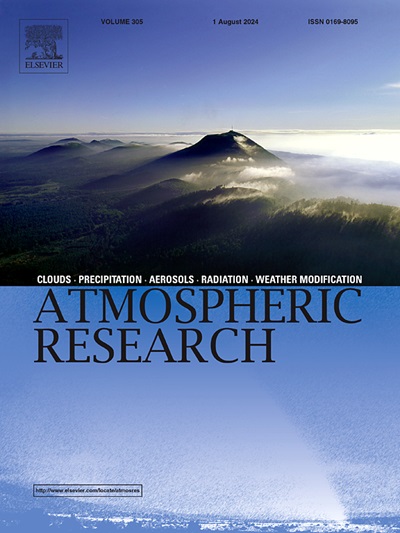Improving aerosol retrieval from FY-3D/MERSI by parameterizing a binary quadratic spectral surface reflectance model with urban percentage and vegetation index
IF 4.4
2区 地球科学
Q1 METEOROLOGY & ATMOSPHERIC SCIENCES
引用次数: 0
Abstract
The Medium Resolution Spectral Imager (MERSI) Dark Target (DT) algorithm, adapted from the Moderate Resolution Imaging Spectroradiometer (MODIS) DT algorithm, demonstrated aerosol retrieval performance similar to that of MODIS Collection 6.1 (C6.1) DT products. However, discrepancies arose in urban areas, where MERSI retrievals tended to exhibit noticeable positive biases, primarily due to the inadequate representation of urban surface reflectance. To address this issue, this study developed an enhanced algorithm by parameterizing a binary quadratic spectral surface reflectance model using urban percentage (UP) and vegetation index, named the MERSI DT_UP algorithm. Global validation against Aerosol Robotic Network (AERONET) measurements showed that MERSI DT_UP retrievals in 2019 exhibited greater accuracy than MERSI DT retrievals. The correlation coefficient between satellite retrievals and AERONET for MERSI DT_UP (R = 0.882) was higher than that for MERSI DT (R = 0.875), and the mean bias was reduced to −0.001 from 0.018. Additionally, the percentage of matchups falling within the expected error envelope (within EE%) of ± (0.05 + 0.2τ) increased by 1.5 %. Across different urbanization levels, MERSI DT_UP retrievals showed significant reductions in mean biases (ranging from 0.003 to 0.217) and notable increases in within EE% (ranging from 2.2 % to 49.3 %) compared to original results. Moreover, improvements were also observed on moderately vegetated and moderately bright surfaces, as demonstrated by the error dependence analysis. The proposed surface reflectance model supports the algorithm development for MERSI and holds potential for application to other sensors.
利用城市百分比和植被指数参数化二元二次光谱表面反射率模型,改进FY-3D/MERSI气溶胶反演
中分辨率光谱成像仪(MERSI)暗目标(DT)算法改编自中分辨率成像光谱辐射计(MODIS) DT算法,其气溶胶检索性能与MODIS Collection 6.1 (C6.1) DT产品相似。然而,差异出现在城市地区,在那里,MERSI检索往往表现出明显的正偏差,主要是由于城市表面反射率的代表性不足。为了解决这一问题,本研究开发了一种基于城市百分比(UP)和植被指数参数化二元二次光谱表面反射率模型的增强算法,命名为MERSI DT_UP算法。针对气溶胶机器人网络(AERONET)测量的全球验证表明,2019年MERSI DT_UP检索比MERSI DT检索具有更高的准确性。MERSI DT_UP与AERONET的相关系数(R = 0.882)高于MERSI DT (R = 0.875),平均偏差从0.018降至- 0.001。此外,落在±(0.05 + 0.2τ)的预期误差包络(EE%)内的配对百分比增加了1.5%。在不同的城市化水平中,MERSI DT_UP检索结果显示,与原始结果相比,平均偏差显著降低(范围从0.003到0.217),EE%内显著增加(范围从2.2%到49.3%)。此外,在中等植被和中等明亮的表面上也观察到改进,正如误差相关性分析所证明的那样。所提出的表面反射率模型支持MERSI的算法开发,并具有应用于其他传感器的潜力。
本文章由计算机程序翻译,如有差异,请以英文原文为准。
求助全文
约1分钟内获得全文
求助全文
来源期刊

Atmospheric Research
地学-气象与大气科学
CiteScore
9.40
自引率
10.90%
发文量
460
审稿时长
47 days
期刊介绍:
The journal publishes scientific papers (research papers, review articles, letters and notes) dealing with the part of the atmosphere where meteorological events occur. Attention is given to all processes extending from the earth surface to the tropopause, but special emphasis continues to be devoted to the physics of clouds, mesoscale meteorology and air pollution, i.e. atmospheric aerosols; microphysical processes; cloud dynamics and thermodynamics; numerical simulation, climatology, climate change and weather modification.
 求助内容:
求助内容: 应助结果提醒方式:
应助结果提醒方式:


